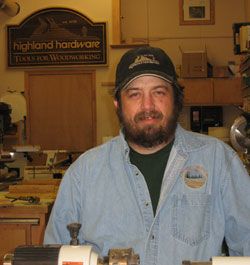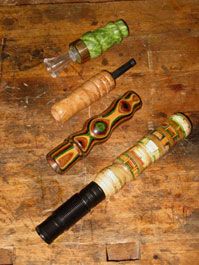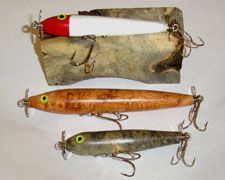
 Doug Hall:
Brian, congratulations on winning our Scratch Awl Turning Contest. Of all the entries, you received the most votes. With this contest being judged by our customers' votes, you should be very proud.
Doug Hall:
Brian, congratulations on winning our Scratch Awl Turning Contest. Of all the entries, you received the most votes. With this contest being judged by our customers' votes, you should be very proud.
Brian Watson: Thank you, I am very proud to have won this contest. They were all good looking projects. It was interesting to see the different shapes of everyone's entries.
DH: What made you decide to enter?
BW: I was looking at the Georgia Woodworkers Guild website and saw a link to your website. I had heard of Highland Woodworking and had passed it a couple of times on my way to Blind Willie's. When I was looking through your website, I saw the contest and it seemed like there were only two or three people entered. So the next day I called and ordered two kits. When I finished them and sent in the pictures, the contest had grown. I thought it would be good for me to see how my turnings "stacked up" next to others' work.
DH: Tell us about how you started in woodworking and when.
 BW:
It was about four years ago; I made my first ammo box. Then I made a few for a couple of friends for Christmas presents. Then I finally got around to finishing my upstairs (after living here for about 15 years). I then found the need for several projects to go along with the "pre - modeling" that I was doing.
BW:
It was about four years ago; I made my first ammo box. Then I made a few for a couple of friends for Christmas presents. Then I finally got around to finishing my upstairs (after living here for about 15 years). I then found the need for several projects to go along with the "pre - modeling" that I was doing.
My first wood turning came a little more than two years ago. My friend and hunting partner, Danny Jones and I were discussing how the commercially made strikers we were using with friction "pot" style turkey calls sounded like crap. So the next thing you know I had bought a late 1960's or early '70's Dremel "Hobby" Lathe from eBay. So we started turning some of our own strikers. Some sounded great, others sounded like dragging a cat backwards through a keyhole. With the right combination of wood types and weight, we got better.
Then one of our other buddies said that we couldn't make strikers without making a call or two. So we did, some bad and some good. We made a few for our other friends and co-workers. Then our buddy chimes in again with "Ya'll ought to sell some of these." Leave it to your buddy to lead you astray and cost you a bunch of time and money!
Now I have 5 lathes and make 3 kinds of turkey calls, deer grunt calls, duck and goose calls, predator calls, cow elk calls, and owl hooters. Then you add pens and the other "kit" type projects, custom knives, boat-shaped book shelves, and ammo boxes. Next add my Outdoor Connection business and a couple days of hunting, and I am busy.
DH: Do you remember your first woodworking project?
BW: I think my very first project was a cutting board in shop class back in high school. Or maybe it was a boot jack - I can't remember.
DH: What has drawn you to turning? Is it a love of wood, form or the process?
BW: I will have to say it is the process. You take a block of wood and inside is a shape or form waiting to show itself and you let it out.
 DH:
I noticed that the piece that you submitted has a wonderful wood, with an amazing amount of figure. What type of wood is it?
DH:
I noticed that the piece that you submitted has a wonderful wood, with an amazing amount of figure. What type of wood is it?
BW: The wood I used for the winning scratch awl is Etowah River Wild Cherry Burl. It is beautiful. I feel like I stacked the deck when I used it to make the scratch awl. It is the favorite here at Old Kerns Game Calls.
DH: What is the most important thing that you look for in your wood selection? With your process, do you decide on a project first then locate the appropriate wood or does a selection of wood "tell you" what it should be?
BW: With the calls that I make, I find that the "look" of the wood is the number one factor. Then price is a close second. Everybody likes something that looks good. The projects I do are, for the most part, taken from standard dimensional wood sizes. Although I do cut some of my own wood, I have used Crepe Myrtle, Red Tip Shrubbery, Pawlonia, Popsicle sticks (Yes, I said Popsicle sticks), and other alternative materials to work with. I recently cut a 100+ year old Holly to use for a few new things I have planned.
 DH:
What type of shop setup do you have?
DH:
What type of shop setup do you have?
BW: A very crowded, knee-deep in sawdust garage is my current set up. I hope to have a small shop built by next summer.
DH: What influences have had the most impact on your work?
BW: One of my influences has been seeing others' work. There are many custom call makers here in Georgia, as well as woodturners of all sorts. I try to draw ideas from both of these and mesh them into my wood works and turnings. I have been trying some segmented turnings lately. I have several ideas on some new designs of calls I would like to try, as well as with the "kit" type projects.
DH: If you were starting in woodworking today, what resources would you seek to advance yourself as a craftsperson?
BW: Some classes in basic woodturning fundamentals and safe tool operation would top my list. The one thing I have found out about being a "craftsperson" is if you call it "Art" you can charge more for it. People will pay for art; if "craft" is mentioned, they want to haggle too much.
 DH:
What advice would you give someone that was starting today, especially regarding the selection of tools and how to design a shop space?
DH:
What advice would you give someone that was starting today, especially regarding the selection of tools and how to design a shop space?
BW: I would have to say to stay away from the "Big Box" stores. I bought a belt/disk sander from one of them. The drive belt wore out on it. The Box doesn't carry repair parts for their Disposable tools. When you decide to buy a tool, research it first and get one that is of good quality. It may or may not cost more, but with use you will save a lot more than money.
I think the best set up for a shop is the start in and finish out. Arrange your tools and/or work stations so that when you bring in the rough supplies to your first station they flow in progression to the last station, with the finished project flowing right on out the door to wherever or to whomever it was designed for.
Brian Watson resides in Dawsonville, Georgia. He may be contacted via e-mail at brianwatson43@hotmail.com .
View a slideshow of Brian's work